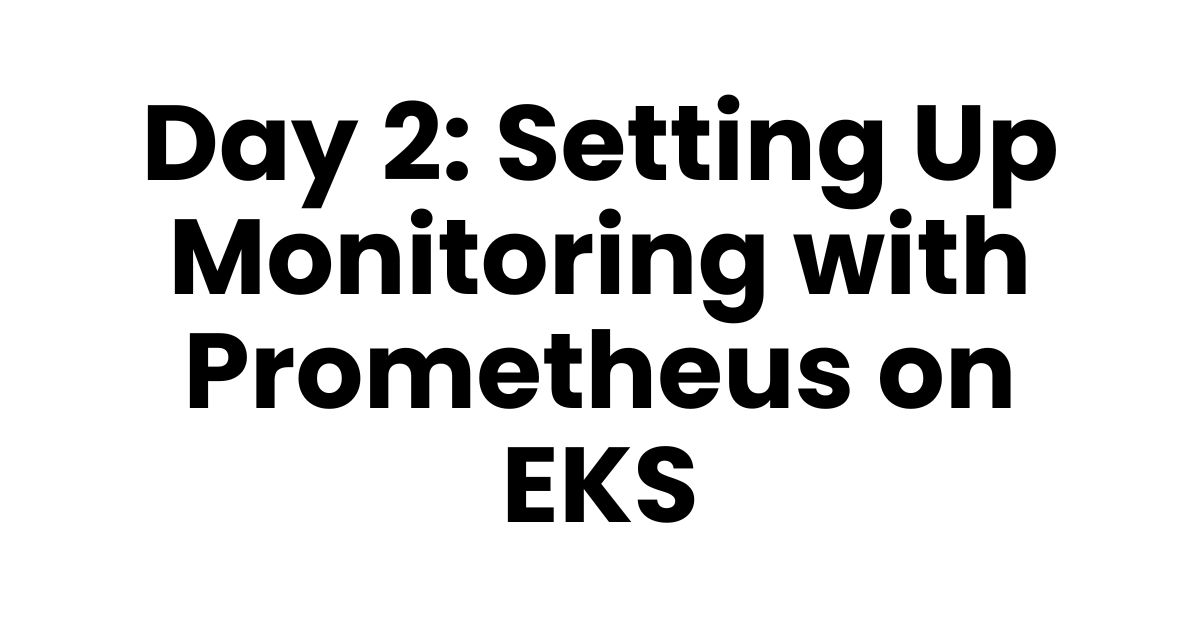Day 2: Setting Up Monitoring with Prometheus on EKS | Basics of Prometheus
 Ali Hassan Khan Yousafzai
Ali Hassan Khan Yousafzai
Certainly! Here's an updated section with the prerequisites before setting up Prometheus on Windows.
Prerequisites for Installing Prometheus on Windows
Before setting up Prometheus on Windows, ensure that your environment is properly configured with the following prerequisites:
Install Docker Desktop:
Docker is essential if you are using containerized applications or want to run Prometheus in a container. Download and install Docker Desktop from the official Docker website.
Ensure Docker is running and the necessary resources (CPU, RAM, etc.) are allocated in the Docker settings.
Enable WSL (Windows Subsystem for Linux):
For an optimal experience, especially if you want to work with Kubernetes, you may need to enable WSL 2 and install a Linux distribution (like Ubuntu) from the Microsoft Store.
Steps to Enable WSL:
Open PowerShell as an administrator and run:
wsl --installRestart your computer once the installation is complete.
For more details on setting up WSL, visit the WSL documentation.
Install
kubectl:kubectlis the command-line tool for interacting with Kubernetes clusters. Download and install it from the official Kubernetes website.Add
kubectlto your PATH: Ensurekubectlis available in your command line by adding its path to your system environment variables.
Install
Helm:Helm is a package manager for Kubernetes, making it easy to manage applications like Prometheus. Download and install Helm from the Helm website.
Verify the installation:
helm versionAdd Helm to your PATH if needed.
Enable Hyper-V (Optional):
- If you are running virtualized environments, you may need to enable Hyper-V on your Windows machine. This can be done through the Windows Features settings.
Set Up Kubernetes:
If you plan to work with a local Kubernetes cluster, consider using Minikube or a managed cloud solution like Amazon EKS. Follow the instructions specific to your choice:
Minikube: Download from Minikube’s site.
EKS Setup: Refer to AWS documentation for detailed guidance.
Install Git (Optional):
- If you plan to clone configuration files or version control your setup scripts, make sure Git is installed on your machine. Download it from Git's website.
These prerequisites will ensure a smooth installation and configuration process, whether you are running Prometheus directly on Windows or using containers in a Kubernetes environment. Once everything is set up, proceed with the installation and configuration steps.
Effective monitoring is a cornerstone of maintaining reliable and performant applications. Prometheus, an open-source systems monitoring and alerting toolkit, has become a favorite among DevOps engineers for its robust features and seamless integration with cloud-native environments like Kubernetes. In this article, we'll cover setting up Prometheus in an Amazon EKS (Elastic Kubernetes Service) cluster and integrating it with Grafana for visualization.
What is Prometheus?
Prometheus is designed for collecting and querying metrics data efficiently. It uses a time-series database, with each metric stored alongside timestamps and labels, which offer insights into performance and behavior. Here's a brief overview of the Prometheus architecture:
Prometheus Server: The core component responsible for scraping and storing metrics from configured targets.
Exporters: Components that expose metrics from services in a Prometheus-compatible format.
Alertmanager: Manages alerts, deduplication, and routing.
Data Storage: Prometheus uses a custom time-series database optimized for high performance.
Why Use Prometheus in Kubernetes?
Kubernetes is highly dynamic, with pods and services frequently changing states. Prometheus efficiently handles such environments through service discovery mechanisms, making it a natural fit for Kubernetes monitoring.
Step-by-Step Guide to Setting Up Prometheus in an EKS Cluster
Prerequisites
An active EKS cluster.
kubectlconfigured to access the cluster.Helmpackage manager installed.
Step 1: Setup and Configuration of Prometheus in EKS
Add the Helm Repository: First, add the
kube-prometheus-stackHelm chart, which bundles Prometheus, Grafana, and Alertmanager for ease of setup:helm repo add prometheus-community https://prometheus-community.github.io/helm-charts helm repo updateInstall kube-Prometheus-stack: Install the
kube-prometheus-stackinto the EKS cluster:helm install prometheus-stack prometheus-community/kube-prometheus-stack --namespace monitoring --create-namespaceThis command deploys Prometheus, Grafana, and other monitoring components in the
monitoringnamespace.Verify the Installation: Ensure that the pods are running:
kubectl get pods -n monitoringYou should see all Prometheus, Grafana, and Alertmanager pods in a
Runningstate.
Step 2: Accessing Grafana for Visualization
Get the Grafana Admin Password: The default password is stored as a Kubernetes secret:
kubectl get secret -n monitoring prometheus-stack-grafana -o jsonpath="{.data.admin-password}" | base64 --decodePort Forward to Access Grafana: To view Grafana in your browser, use:
kubectl port-forward -n monitoring svc/prometheus-stack-grafana 3000:80Now, visit
http://localhost:3000and log in withadminas the username and the retrieved password.
Step 3: Basic Prometheus Queries for Monitoring
Prometheus uses its own query language called PromQL. Here are some basic queries to get you started:
Check Memory Usage:
node_memory_Active_bytesCPU Usage Across All Nodes:
sum(rate(node_cpu_seconds_total{mode!="idle"}[5m]))Number of Running Pods:
count(kube_pod_info)
Integrating Prometheus with Grafana
Add Prometheus as a Data Source in Grafana:
Go to
Configuration > Data Sourcesin Grafana.Click
Add data source, selectPrometheus, and enter the Prometheus server URL (e.g.,http://prometheus-stack-prometheus:9090).
Create Dashboards for Visualization:
- Import pre-built dashboards or create custom ones to monitor the metrics relevant to your infrastructure.
Key Takeaways
You now have a functional Prometheus and Grafana setup in your EKS cluster.
You learned how to install and configure Prometheus on Kubernetes using Helm.
You explored basic PromQL queries to start monitoring critical metrics.
By mastering these steps, you'll gain insights into your applications' performance, helping you proactively address issues. In the next sessions, we'll dive deeper into customizing alerts and fine-tuning your monitoring setup.
Subscribe to my newsletter
Read articles from Ali Hassan Khan Yousafzai directly inside your inbox. Subscribe to the newsletter, and don't miss out.
Written by

Ali Hassan Khan Yousafzai
Ali Hassan Khan Yousafzai
As a DevOps Engineer at Polymer SaaS DLP, I orchestrate seamless deployments for optimal performance, leveraging cloud-native technologies and infrastructure as code (IaC) tools. I have implemented CI/CD pipelines, monitoring and logging solutions, and automated testing frameworks to streamline development and enhance scalability. I have also contributed to resolving complex issues, optimizing resource utilization, and ensuring security and compliance standards.